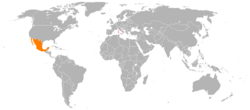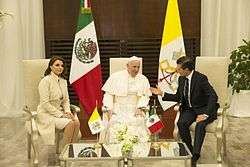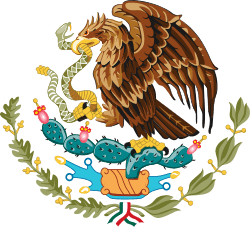Holy See–Mexico relations
 | |
Holy See |
Mexico |
|---|---|
Holy See – Mexico relations are foreign relations between the Holy See and Mexico. The Vatican assigned an Apostolic Delegate as resident representative in Mexico in 1904, after diplomatic relations had earlier been broken off.[1] In 1992, diplomatic relations were restored and resident diplomatic missions were established in each other's capitals, respectively. As of 1990, about 90 percent of Mexico's 86 million people declared themselves Roman Catholics.[1]
The current apostolic nuncio of the Holy See to Mexico is Archbishop Franco Coppola.
History

Mexico and the Vatican broke diplomatic relations after President Benito Juárez confiscated church property between 1856 and 1861. He disbanded religious orders and ordered the separation of church and state in the new Constitution of Mexico. Some of the powers of the Catholic Church were reinstated by the dictator Porfirio Diaz.[1][2]
In 1926, after several years of the Mexican revolutionary war and insecurity, President Plutarco Elías Calles, an atheist and leader of the ruling National Revolutionary Party, enacted the Calles Law, which eradicated all the personal property of the churches, closed churches that were not registered with the State, and prohibited clerics from holding a public office. The law was unpopular, and several protesters from rural areas fought against federal troops in what became known as the Cristero War. After the war's end in 1929, President Emilio Portes Gil upheld a previous truce where the law would remain enacted, but not enforced, in exchange for the hostilities to end.
In 1992, after more than 130 years, the Mexican Government re-established formal diplomatic relations with the Holy See and restored civil rights to the Roman Catholic Church in Mexico.[1][2]
For the first time in 2016, a Pope (Pope Francis) was invited in the National Palace in Mexico.[3] Upon his return from Mexico, regarding the Trump wall dividing the USA and Mexico, Pope Francis took Mexico's side when he told the press "Anyone, whoever he is, who only wants to build walls and not bridges is not a Christian."[4]
State visits
Papal visits from the Holy See to Mexico[5]
- Pope John Paul II (1979, 1990, 1993, 1999, 2002[6])
- Pope Benedict XVI (2012[7])
- Pope Francis (2016[3])
Presidential visits from Mexico to the Holy See
- President Luis Echeverría (1974)
- President Carlos Salinas de Gortari (1991)
- President Ernesto Zedillo (1996)
- President Vicente Fox (2001)
- President Felipe Calderón (2007, 2011)
- President Enrique Peña Nieto (2013, 2014)
Resident diplomatic missions
- The Holy See has an Apostolic Nunciature in Mexico City.[8]
- Mexico has a resident embassy to the Holy See in Rome.[9]
See also
References
- 1 2 3 4 Rohter, Larry (February 15, 1990). "Mexico and Vatican Move Toward Restoring Ties". New York Times. Retrieved 2009-06-12.
After more than a century of estrangement, the Mexican Government and the Vatican are suddenly moving toward re-establishing formal diplomatic relations and are also having informal talks on restoring some civil rights to the Roman Catholic Church here.
- 1 2 Golden, Tim (September 22, 1992). "Mexico and the Catholic Church Restore Full Diplomatic Ties". New York Times. Retrieved 2009-06-12.
Mexico and the Vatican re-established full diplomatic relations today after a break of more than 130 years, completing a reconciliation based on the Government's restoration of legal rights to religious groups earlier this year.
- 1 2 Pope Francis tells Mexico leaders: Nation needs 'true justice', Rappler.com, 13 February 2016
- ↑ Pope Francis says Donald Trump is 'not Christian' because of immigration policies, Abc.net, 18 February 2016
- ↑ Los Presidentes de México en el Vaticano (in Spanish)
- ↑ Ronald Hilton, MEXICO: Pope John Paul II, Stanford.edu, 1 August 2002
- ↑ Josephine McKenna, The Olé Pope: Benedict dons a Mexican sombrero as he preaches Mass to 30,000, Telegraph.co.uk, 25 March 2012
- ↑ Apostolic Nunciature of the Holy See in Mexico City (in Spanish)
- ↑ Embassy of Mexico to the Holy See (in Spanish)

